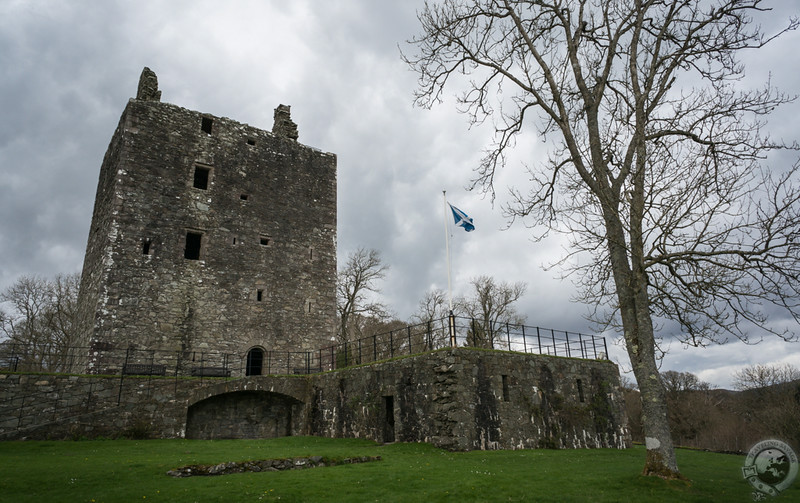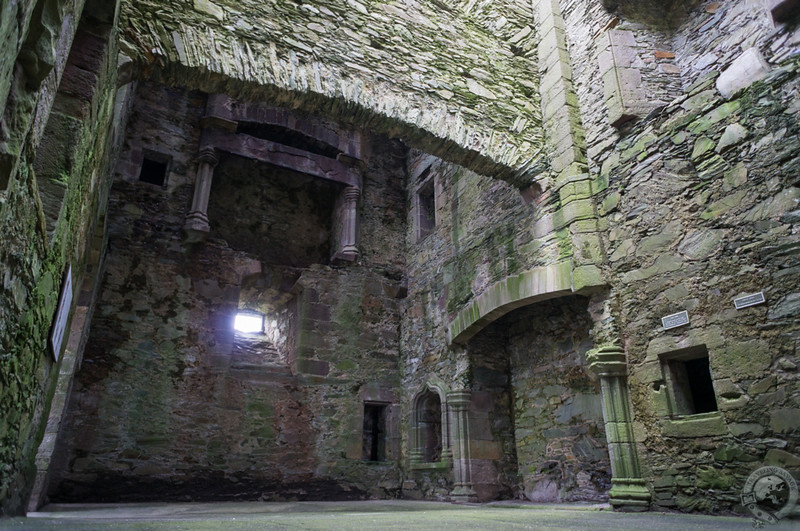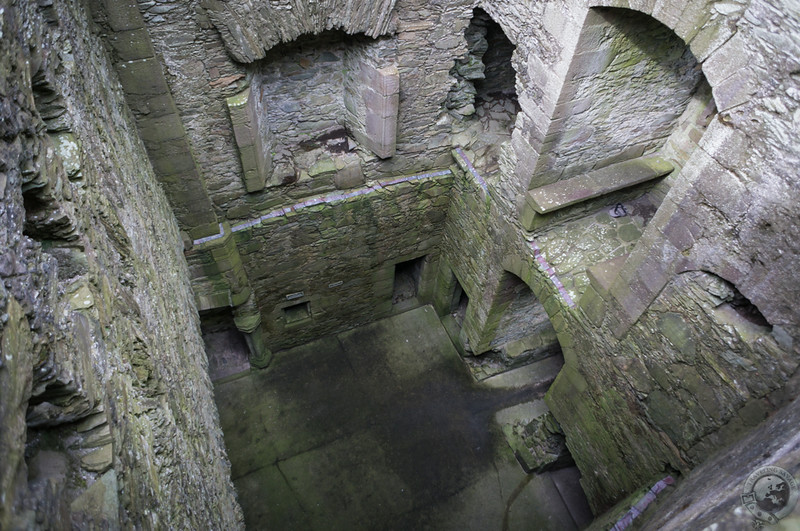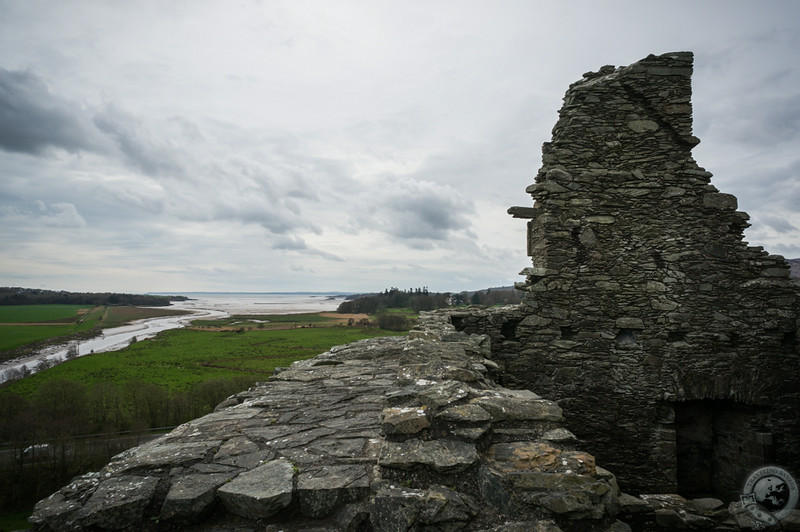The Galloway countryside is riddled with old stone fortresses and places of worship that have faded into antiquity. They stand on hills overlooking glens or hidden beneath the eaves of mixed woodland, once part of the natural order of life. These days, tourism has cast great spotlights on such places and wrapped them in parking lots, visitor centers, and exhibitions, and with this packaging the sites have lost a measure of their mystique. The quest becomes to find those sites that have escaped this fate, that languish in anonymity or mis-remembrance, for they do exist out in the wilds of Scotland. Sometimes they are little more than names at the bottom of a list, nominally governed by a charity.
Perhaps Cardoness Castle is the easiest, though not the most extreme, such example to find. Standing just off the A75 south of Gatehouse of Fleet, Cardoness Castle is a well-preserved medieval tower house overlooking Fleet Bay. It’s easy to miss from the main road, and I even drove past it after turning off the A75. When I turned around I wondered how I could have missed it. There it was – bang – looming atop a hill that used to be lapped by the waters of the bay, dour beneath the roiling overcast sky. Sure, there was a tiny parking lot and a cozy visitor center that I passed through on my way up to the castle, but there were no people.
I had the castle and all its ghosts to myself.
Cardoness, like many castles, has a colorful history, and black would be the most prevalent of all those colors. The origin of Cardoness Castle is a bit sketchy, but it seems likely that it was built by an Anglo-Norman lord named Nicholas de Kerdenes on the recommendation of the king of Scotland, who sought to weaken the power of the Lords of Galloway by importing foreign lords. History has shown this to be a poor strategy, as the Britons could attest. They brought over Saxons, Angles, Jutes, and Frisians to protect them from the Gaels and Picts after the fall of Roman governance and, well, the rest is history.
The de Kerdenes flourished or at least survived until the 14th century when the laird blew his fortune building the castle we see today. To replenish his resources, the laird did the only sensible thing at the time: He took up border thieving. However, after decades of considerable plunder, his wife had failed to produce an heir. She’d given him nine daughters but nary a son. This de Kerdenes laird clearly had some questionable morals, so it came as no surprise to me when I learned he threatened to drown his wife and their nine daughters in the Black Loch if she didn’t produce a son. The threat seemed to have triggered something, for lo and behold his wife gave birth to a son soon thereafter. It being the dead of winter, there was no better place to throw a feast to celebrate the birth of his son than atop the frozen loch.
The laird’s black humor did not go unpunished.
At the height of the revels, the ice over the black loch gave way and all gathered plunged to icy deaths. All except one daughter who was unable to attend for an unknown reason. This daughter married a MacCulloch, one of the laird’s rivals, and so ended the reign of the de Kerdenes.
Cardoness Castle is a tower house, meaning the structure is a rectangular pile that would have been composed of multiple (mostly wooden) floors. A cramped circular stair spirals up through the walls with openings at each level of the tower house. The ground floor was used to store provisions and serve as a prison when needed. Cardoness possessed upper and lower prisons – the main difference being the lower prison was an airless, lightless tomb for the blackest of enemies. The main floor houses the great hall where the laird would entertain guests and hold business meetings. The floors above the great hall were reserved for the family’s bed chambers.
There’s quite a bit of preserved stonework throughout the castle, which has a hollow, eerie feel as the Scottish winds keen through the small windows.
The MacCullochs didn’t exactly improve upon the reputation of Cardoness Castle. Alexander MacCulloch, who died upon the Flodden Field in 1513, was a master archer and keeper of the king’s falcon. He was also convicted of violence against neighbors twice and only the king’s hand could save him from the Maiden (Scottish guillotine). In the second half of the 17th century, another Alexander MacCulloch, in dispute with the Gordons over land, dragged an elderly, sickly woman from her bed and threw her on a dung heap to die. His son, Godfrey, later killed a Gordon and was subsequently beheaded in Edinburgh. That’s one nasty family tree.
The stairs inside the walls of Cardoness Castle lead up to the ruined ramparts, which provide an excellent view of the Water of Fleet flowing into the bay. It takes little imagination to see how this would have been an easily defensible position, or one from which to prey on travelers and traders. Robber barons were also known to build a castle or two in their time. I can’t suppress the nostalgia; at least the robber barons of yesteryear could be seen and rousted out with flames and pitchforks.
Cardoness Castle is an easy stop along the A75 that everyone with a half hour to spare should make. It is a beautifully preserved castle with a rich history. The best part? It’s not overrun by tourists. Not yet, at least.
Historic Scotland provided me with a complimentary visitor pass. All thoughts and opinions expressed here are my own.





Spectacular interior photos — thanks!
Keith,
We’re here in Scotland, and I’ll post at length later in the week or on our return. This new posts arrived in my inbox tonight, and we just visited a place which perfectly matches. Just east of Cawdor Castle, off the B9090, is Rait Castle. It’s really a hall house, but it’s in ruins. To get there from Cawdor, go a mile or so, through Piperhill, then through Geddes. Look for a Trout Fishery sign on the right, then take the very next right beyond that. It’s a single lane, dirt farm track. Go slow, there’s cows there. It’s quite a ways down, but ends in a big enough area to turn the car around. Park there, and there’s as bigger road gate and a smaller one off to the left of the road. The small gate was opened a bit. Follow the trampled grasses forward about 40 ft, around to the right ten feet, and there’s a beautiful ruin there.
If there’s a way to post pictures, I will. If not, then I can send them to you if you would like to see/show them, Keith.
That sounds amazing, Ray. Most people stop at Cawdor (justifiably so), but with a little exploration look what you can find. This kind of thing happens all over Scotland. What an allure! Thanks for the instructions – I know that area well and I will keep my eyes peeled for Rait Castle next time I’m up near Nairn. If you can’t put a photo in the comments, a link will do! I’m sure others would like to see it, too.
Some wonderful, moody pictures. Really excites the imagination to consider what life had been like in those days.
Nice read Keith, and some great snaps of the interior. Certainly sounds/looks like an atmospheric spot. Built by a thief and lived in by murderers, one of many such castles in Scotland I bet. And nice you had this one all to yourself.
Unusual that it was so empty. Usually there’s at least one other person ambling around. Got lucky!
You can just feel the essence of Scotland in these photos … the brooding clouds above, combined with the old rugged stone makes for an atmosphere that is unmatched anywhere. Great post!